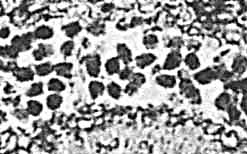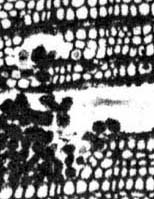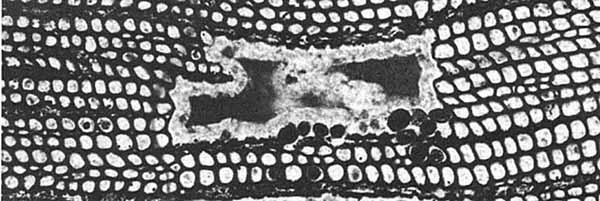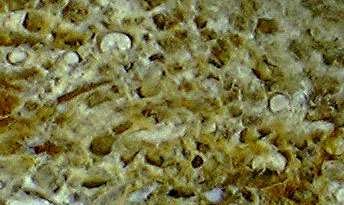Cell-size clots in fossil wood
--- no coprolites
Cell-size clots in fossil wood are
the results
of some process which requires an
explanation. As a favourite explanation found in many publications
worldwide, small arthropods are thought to have gnawn tunnels
or galleries through the tissue. They were never seen but dark
clots interpreted as coprolites were taken as evidence for their temporal
presence.
Those interpretations are fraught with glaring discrepancies which
none of the authors seemed to have noticed: The alleged mite coprolites
are often angular, with edges and plane
side faces like the inside of the nearby cells. Hence they are no
coprolites but clots grown inside cells.




Fig.1: Alleged mite coprolites [1]
but really clots shaped like cells.
Fig.2: Psaronius root
cells [2] empty or with black fill.
Fig.3: Coniferous wood tissue allegedly damaged by
mites [3]; no coprolites but cell-size clots.
Fig.4: Similar as Fig.3; round clots growing within cells in rows and finally getting
out [4].

As a big surprise after much vain
talk
by experts about mite coprolites without
mites, the fossil collector Gert
Müller, carpenter by profession, seems
to have found the elusive arthropods in their
burrows in plant tissue preserved in chert
(Fig.5) but nothing in this picture looks like coprolites fitting to the creatures.
Incidentally,
G.
Müller had
been the first one to
raise severe doubts about the alleged mite coprolites in [2].
Fig.5:
Juvenile (?) arthropods in degraded tree fern tissue in Lower
Permian chert, Döhlen basin, Saxony.
Width of the picture about 3mm. Sample and photograph by Gert Müller [5].
The authors of the numerous publications involving alleged oribatid mite coprolites in fossil
wood did not see what could be seen in a few pictures like these ones:
The cell-size clots offered as mite coprolites are no such. This had
been
explained as early as 2007 [6] and repeatedly
afterwards. In a new
publication [7] on an old sample [2],
proponents of the coprolite hypothesis
tacitly
admitted their error as late as 2017 by simply not mentioning
the alleged coprolites any more. This implies the question what the
clots could be if not coprolites. The answer can be found in
publications on Early Land Plants from the Devonian which are
frequently infested with the fungus Glomites.
The tiny hyphae of that fungus form dense tangles appearing as dark
clots inside cells, and they can spread to neighbouring cells [8].
Apparently some fungus had produced the clots in fossil wood, too.
Considering that the authors R.
Rößler and
Z. Feng are
responsible for erroneous publications on arthropod coprolites for
decades, the recent publication
[9] should be regarded with suspicion.
H.-J.
Weiss 2023
[1]
R. Rößler: The late palaeozoic tree fern Psaronius - an
ecosystem unto itself. Rev. Palaeobot. Palyn. 108(2000), 55-74.
[2] M. Barthel,
M.
Krings, R. Rößler: Die schwarzen Psaronien von Manebach,
ihre Epiphyten, Parasiten und Pilze. Semana 25(2010), 41-60.
[3] R. Rößler,
R. Kretzschmar, Z. Feng, R. Noll: Fraßgalerien von
Mikroarthropoden in Konifernhölzern des frühen Perms von Crock,
Thüringen.
Veröff. Mus. Naturkunde Chemnitz
37(2014), 55-66.
[4]
Z. Feng, J.W. Schneider, C.C. Labandeira, R. Kretzschmar, R. Rößler:
A specialized feeding habit of Early Permian oribatid mites.
Palaeogeography, Palaeoclimatology,
Palaeoecology 417(2015), 121-124.
[5]
Gert Müller: private communication.
[6]
H.-J. Weiss: 6. Chert Workshop 2007,
Naturkunde-Museum Chemnitz.
[7] M. Krings,
C.J. Harper, J.F. White, M. Barthel, J. Heinrichs, E.L. Taylor, T.N.
Taylor:
Fungi in a Psaronius root mantle from the Rotliegend (Lower Permian) of
Thuringia,
Rev. Pal. Pal. 239 (2017), 14-30.
[8] H.
Kerp: De Onder-Devonische Rhynie Chert ... . Grondboor
& Hamer 58(2004), 33-50.
[9]
Z. Feng, M. Bertling, R. Noll, A. Slipinski, R. Rößler:
Beetle borings in wood with host response in early Permian conifers
from Germany, Paläontol. Z. (July 2019).
|

|
 45 45 |

 45
45





 45
45